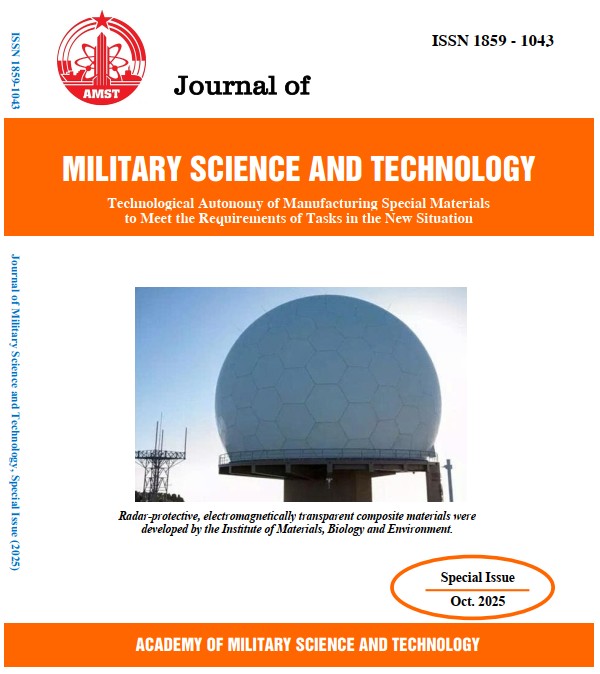Đánh giá hiệu quả ức chế ăn mòn của Inkort 8MZ.VN ứng dụng trong hệ thống làm mát máy phát điện diesel hoạt động trong môi trường biển
DOI:
https://doi.org/10.54939/1859-1043.j.mst.IMBE.2025.228-234Từ khóa:
Thép CT3; Chất ức chế ăn mòn; Inkort8MZ.VN; Ăn mòn trong dung dịch NaCl; Điện hóa.Tóm tắt
Nghiên cứu này khảo sát hiệu suất ức chế ăn mòn của chất ức chế Inkort8MZ.VN trên thép cacbon CT3 trong dung dịch NaCl 3,5% (tương đương độ mặn của nước biển ở vùng biển Việt Nam). Hiệu suất ức chế tối ưu (> 99%) đạt được khi sử dụng 2% Inkort 8MZ.VN, bằng chứng là tốc độ ăn mòn giảm đáng kể, mật độ dòng điện anốt/catốt và tổng điện trở chống ăn mòn (Rₙ= Rfilm + Rct) tăng hai bậc. EIS sử dụng mạch Randles mô phỏng đã xác nhận sự hình thành của một lớp màng bảo vệ (Rfilm) trên lớp kép, làm giảm Cdl và tăng Rct. Những hiệu ứng này phù hợp với các quan sát về vi cấu trúc từ SEM. Kết quả chứng minh Inkort 8MZ.VN ở nồng độ tối ưu có hiệu quả bảo vệ chống lại sự ăn mòn do clorua gây ra trong hệ thống làm mát máy phát điện diesel khi hoạt động trong môi trường biển.
Tài liệu tham khảo
[1]. Finsgar, M., and J. Jackson, “Application of corrosion inhibitors for steels in acidic media for the oil and gas industry: A review,” Corrosion Science, 172, p. 108635, (2020).
[2]. Feliu, S. Jr., V. Barranco, et al., “Advances in electrochemical methods for studying corrosion of steels in chloride environments,” Metals, 10(6), p. 775, (2020).
[3]. Verma, C., E. E. Ebenso, and M. A. Quraishi, “Organic corrosion inhibitors for industrial applications: Progress and challenges,” Journal of Molecular Liquids, 321, p. 114385, (2021).
[4]. De Ketelaere, E., D. Moed, M. Vanoppen, et al., “Sodium silicate corrosion inhibition behaviour in saline environments,” Corrosion Science, 217, p. 111119, (2022).
[5]. Li, J., et al., “Sodium silicate as a corrosion inhibitor for AZ31 magnesium alloy in chloride solutions,” Surface and Coatings Technology, 476, p. 129115, (2024).
[6]. Ahmed, M. A., et al., “Recent developments in eco-friendly corrosion inhibitors: A critical review,” Journal of Molecular Liquids, 398, p. 123456, (2024).
[7]. Kaya, S., et al., “Theoretical insights into silicate-based inhibitors for steel corrosion,” Journal of the Taiwan Institute of Chemical Engineers, 132, p. 104133, (2022).
[8]. Shi, W., et al., “Application of potentiodynamic polarization for corrosion rate determination of steel,” Electrochimica Acta, 388, p. 138552, (2021).
[9]. “Advances in impedance spectroscopy for inhibitor evaluation,” International Journal of Corrosion Scale Inhibition, 11(3), pp. 1303–1318, (2022).
[10]. Zhang, R., D. Sur, et al., “Bayesian assessment of equivalent circuit models in corrosion analysis,” Electrochimica Acta, 481, p. 142345, (2024).
[11]. Mainier, F. B., “Proposal of the use sodium silicate as a corrosion inhibitor for carbon steel,” International Journal of Advanced Engineering Research and Science, (2018).
[12]. “EIS technology for film-forming inhibitors,” International Journal of Corrosion Scale Inhibition, 11(3), pp. 1303–1318, (2022).







